Last night we had agreed to head over to a couple of islands farther down the reef, where we could see more birds and snorkel. We met at 10:00 and loaded into John’s boat. It was low tide. When we passed Monkey Island, we realized that the “reef” around the motu was actually the island itself submerged by high tide. Oops. We paralleled the reef around Suwarrow the entire ride, and it looks like the reef is a solid land mass that can be easily walked in low tide. Later, John confirmed that you can walk around the whole island on the reef (except for the passes).
We passed several small motus (islands) before John stopped at a larger one. There were a lot of bushes and trees around. The ground was rocky with chunks of coral and shells.
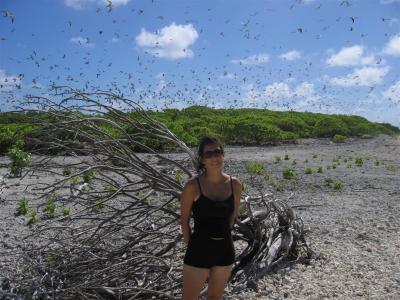
There were several white tropicbirds and boobies flying around and a couple of babies on the ground.
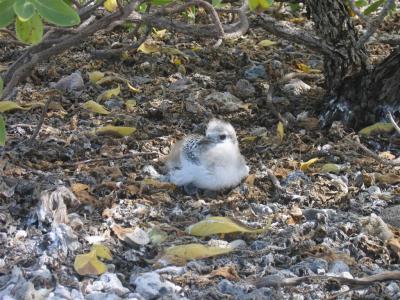
The adults walked the length of the motu while the children fished. As we came into view of the next motu, we could see it was covered in birds, like Bird Island. We trudged through the knee deep water between the motus, and as we approached, thousands of birds took to the sky. Christi is standing on a part of the reef that is covered by water when the tide is higher.
Unlike Bird Island, these birds were all the same species, sooty stern.
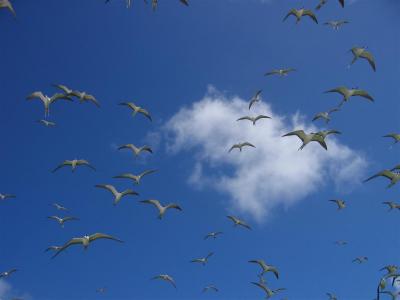
Any spot of ground with foliage to hide an egg under was literally covered with bird eggs. Look carefully, there are at least 14 eggs in this photo.
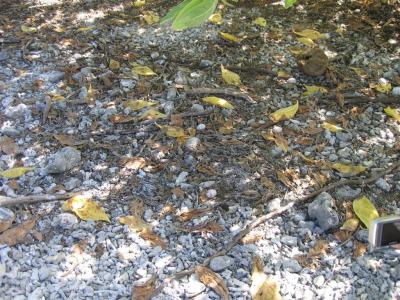
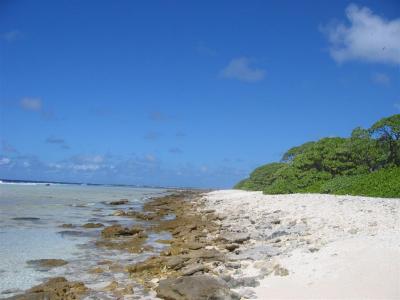
John explained to us that seafaring birds and their eggs are popular foods in the Cook’s. Many of the species here are vanishing from the other islands from over consumption, hence the need for the nature preserve.
We walked the length of the stern motu and trudged through more knee deep water to the next motu. This motu was supposed to have a lot of coconut crabs. We didn’t notice any, but a few cruisers in our group did. They said they look like a cross between a crab and a lobster. We got almost to the end of this motu and headed back as John had instructed us. Later, when John got Eric and I alone, he told us that he would have shown the two of us how to find the crabs, but there were certain people in our group that he didn’t want to show, suspicious that they would sneak back later to catch and eat them. Like in French Polynesia, coconut crabs are also becoming scarce and need to be preserved.
When we got back to the boat, we were delighted to hear that the boys had caught four fish. John and Veronica surprised us with lunch. They had brought crackers, canned corned beef and canned spaghetti. They put the corned beef on the crackers and topped it with a generous amount of spaghetti. We both passed on lunch and opted for the Cliff bars we had brought along. It amazes us how generous this family is. They have so little for themselves, yet happily share anything and everything they have with you.
Once lunch was finished, we loaded into the boat and headed off to the snorkel site. It was a really nice site. The coral heads were huge. They were covered in a plant that we mentioned in Moorea that almost looked like pieces of thin cloth or tissue paper glued to the rock. In Moorea it was pink, here it was almost all green, with only one light pink spot that we noticed. We saw an enormous Napolean fish, a black tipped reef shark, some parrotfish, a couple purple pincushion starfish, the usual collection of tiny fish that live in the branchy coral, and much more.
When we were done snorkeling, John took us back to shore. We saw a couple of sailboats had arrived while we were out. As we were leaving the dock, John asked if we would like one of the fish. We said sure without thinking. He pulled out a whole yellow snapper and handed it to Christi. At that moment Christi realized she was going to have to clean this one herself. “It’s OK. You’ve done it before, you can do it again” she thought as she held the slimy, scaly fish in her hands on the short ride back to Kosmos.
Back on board, she immediately got to work on the fish. This one was bigger and harder to cut through than the little red myripristis amaena we had in South Fakarava. As she worked, she threw the guts, scales, head, tail and fins overboard. Only a few minutes into the project, four large sharks began circling the back of the boat. They got so close to the back and passed so often that Christi was getting nervous, envisioning a shark leaping out of the water and landing on the deck ready to eat a person, like in “Jaws”. It has been explained to us that in most places the sharks don’t get too riled up over small amounts of blood in the water, but here they are more aggressive and are quick to attack if there is blood in the water. They totally ignore you if there is no blood around, but they are on you in an instant when blood is spilled. Spear fishing is prohibited for this reason. Christi was relieved when she was done and could retreat to safety inside Kosmos.
Just as she finished up, Denise called to tell us that there was a birthday girl aboard one of the boats that had just arrived. That, of course, meant a party was necessary. We had an Italian themed meal, with the cruisers doing all the cooking for John and Veronica. Veronica later told us it is the first time the cruisers have done all the cooking and that she appreciated the night off from cooking. This party was a little more laid back than the night before. The birthday girl, Joanne, got a crown similar to, but a little fancier than, Kip and Denise’s. John played some rock songs for us. We hung out and chatted. It was a nice night in a fabulous setting. It is hard to believe we are really here.
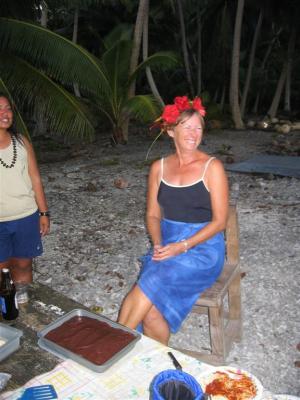

I’m so happy for you two. This, so far to me, sounds like the best place you’ve been yet! I wish I could have seen the sharks though.
Are you two taking any video that at some point later will be uploaded to stage6 or anything?